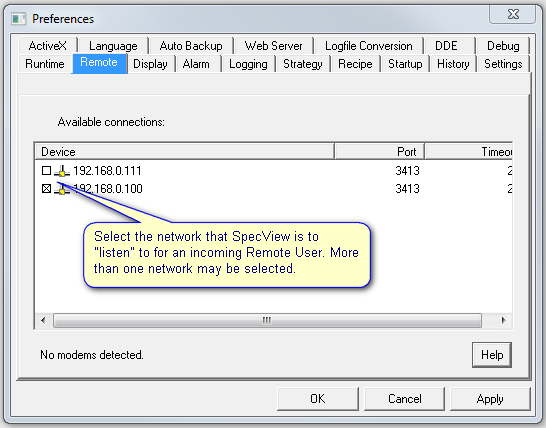|
<< Click to Display Table of Contents >> Multiple Users - Testing with Telnet |
  
|
|
<< Click to Display Table of Contents >> Multiple Users - Testing with Telnet |
  
|
If the Remote is unable to connect then there is a tool called Telnet available in Windows which can be used to test a connection between a Local and a Remote.
The Telnet command can be used to check to see if SpecView has any chance of connecting to a remote computer on a given IP address and Port over TCP.
(UsingTelnet is like knocking on the front door to see if anyone is at that address)
On Windows 7 (and newer versions of Windows) the telnet client utility program is not available by default.
Administrator privileges will be required to enable it.
Go to the Windows Control Panel ‘Programs and Features’ to enable it, see below:

Once telnet is enabled on the Remote, be sure that SpecView is running on the Local, and check on the File-Preferences Remote tab that it is listening:

Then open a Windows Command Prompt. (If it is already open then close and re-open it).
then enter, for example:
telnet 192.168.1.99 3413
Note the space after 'telnet' and the space before the '3413'.
The number 3413 is the port number, this number has been specifically assigned for use by SpecView Remote connections by IANA.org (Internet Assigned Numbers Authority).
It isn't absolutely necessary to use the port number 3413 - just so long as if it is changed then it is changed at both the SpecView Local and Remote.
The reason IANA assigns numbers is just to avoid conflict between software from different suppliers.
If this gives an error such as: Connecting To 192.168.1.99...Could not open connection to the host, on port 3413: Connect failed
then there is a problem with the network.
In which case it will be necessary to setup or check the rule specified in the Windows Firewall, using the Windows Control Panel.
Below are instructions for Windows 7:
From the Windows Control Panel select the Network and Sharing Center
Windows Firewall (at bottom left):

Then click Advanced Settings (on left)
and Inbound Rules (on left)
New Rule... (on right)
Select: Port
Click [Next >]
Select: Specfic local ports and enter: 3413
Click [Next >]
Allow the connection
Click [Next >]
Tick the boxes (Domain/Private/Public) for which this rule should apply
Click [Next >]
Enter a suitable name, for example:
Name: SpecView networking 3413
Description: Allow port 3413 in for SpecView Networking
Click [OK]
Then if running telnet (for example: telnet 192.168.1.99 3413) from the Windows Command Prompt gives a blank screen with a flashing prompt, then it has connected successfully.
Press CTRL+] to get a ‘>’ prompt, then to close telnet type: quit
If telnet connected successfully, then once telnet has closed (it is not possible to have both telnet and SpecView connected at the same time) then SpecView should be able to connect.
If not then please contact your SpecView Representative .